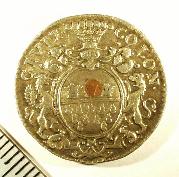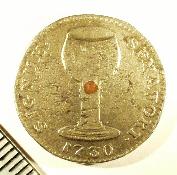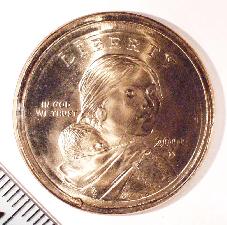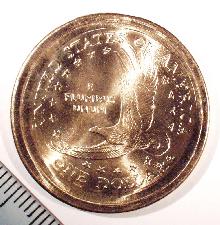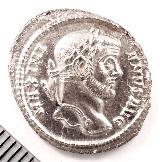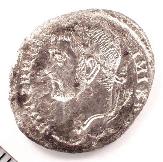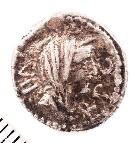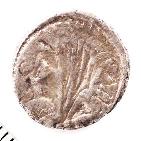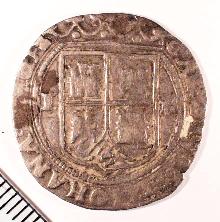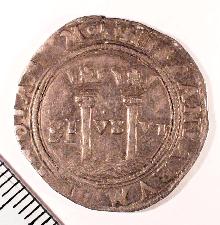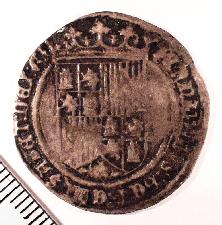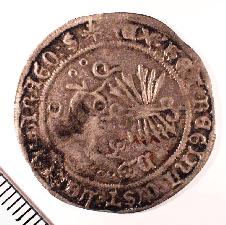Chatter
archive
also available
| Chicago Coin Club |
|---|
| Volume 46 No. 11 |
November 2000 |
|---|
Minutes of the 981st Meeting
The 981st meeting of the CCC was called to order by President Carl Wolf on October 11, 2000.
There were 20 members present along with four visitors.
The visitors were Jean DeLorey, Alan Flint,
J.A. Scott, and Andrea Weaver.
September minutes, as published in the Chatter, were approved.
In the absence of Dick Hamilton there was no Secretary/Treasurer's report.
The speaker for the evening was Tom Delorey.
His topic was "Recent U.S. Mint Errors".
The exhibitors for the evening were:
-
Sharon Blocker- Vintage Dime holders from various banks and organizations.
-
Drew Mjichyeta - U.S. regional scenes depicted on U.S. coins, and representations/symbols of Liberty.
-
Steve Zitowsky - Early bimetallic coin from the city of Cologne.
-
Carl Wolf - Examples of Nigerian "Hoe Money".
-
Bob Leonard - Books and other literature relating to the S.S.
Central America disaster.
Also displayed gold dust recovered from the ship.
-
Bill Bierly - Gallery Mint Museum reproductions of 1804 Dollar and of several early Large Cents.
-
Don Dool - Argentine 2 Peso and other coins, stamps and currency portraying San Martin.
-
Reid Geisler - Modern error coins including double struck cent, nickel on dime planchet, and several others.
-
Mark Wieclaw - Official elongated Australian Olympic Coins and ancient Roman coin brockages.
-
Bob Feiler- Medal with heads of six kings of Spain.
Old Business: Motion was made and carried approving the Archivist's public display
of past club awards, plaques, and various other memorabilia of interest at member
Bill Burd's shop, The Chicago Coin Company, located at 6455 W.
Archer Avenue in Chicago.
The 1999 Financial Report as audited by Dennis Feller and Bill Burd and compiled
by Secretary Treasurer Richard Hamilton was approved as published
in the October edition of the Chatter.
Mark Wieclaw, Chairman of the Nominations Committee, announced the Committee's
nominations for 2001-2002 officers and directors as follow:
-
Carl Wolf - President
-
Bob Feiler - 1st VP
-
Don Dool - 2nd VP
-
Bill Burd - Director
-
Jeff Rossinia - Director
-
Bill Bierly - Director
-
Phil Carrigan - Archivist
-
As the immediate Past President, Mark Wieclaw will also serve as Director.
It was brought to members' attention that the club auction will be held at the November meeting.
Members intending to auction items should provide a list to Paul Hybert
by fax or email for listing in the Chatter.
Members were also reminded to bring their checkbooks or smaller bills
for their purchases as it is difficult during the meeting to make change for larger bills.
Joe Tomasko, Past Archivist, turned over current records and inventory
of safety deposit box contents along with 2 keys to President Carl Wolf.
Respectfully Submitted,
Bill Bierly, Acting as Secretary Treasurer
Speaker's Wor[l]d
A Workshop for Their Gain?
- Modern Errors, Accidental or Not -
Tom DeLorey has studied coins and minting procedures for many years.
After finding error coins in his pocket change,
he would write a letter to the Collectors' Clearinghouse
column of Coin World.
That led to his employment as a writer for Coin World;
to be followed by work at ANACS;
and he now works for Harlan Berk in Chicago.
The mint did not provide collectors of error coins
with much material through the 1980s and early 1990s,
but that situation has changed within the last two years.
Without a detailed knowledge of current mint procedures,
collectors must make educated guesses as to the causes
of the increased errors,
but two reasons seem obvious:
-
Larger production runs.
With more coins being produced,
more error coins will slip out even if the
ratio of error pieces to good pieces stays the same.
The Sacagawea dollar and the state quarter programs
are definitely causing the mint to produce more coins.
-
Changing a set procedure.
Faulty items can be produced from even the best assembly line;
make a change to that assembly line to make a different product,
and the transition period is likely to generate errors.
Using a combination of pictures from the numismatic press
and coins loaned by Fred Weinberg
for this prentation, Tom addressed most of the recent errors.
First up was the wrong metal error of a Susan B Anthony dollar
on a planchet for the Sacagawea dollar.
There are currently three of these known,
and they are reminiscent of the 1943 copper cents
and the 1944 steel cents.
The only odd point is the occurrence
of an old design on a new type of planchet,
but this could be explained by the mint's
production of both coin types in late 1999.
Next examined were the Sacagawea dollar design
struck on the outer ring of a Canadian $2 dollar piece,
and a Sacagawea dollar struck over a seven sided
Barbados dollar (which is a normal product of the
Canadian Mint in Winnipeg).
Hmmm, anything here point to a connection between
the Canadian Mint and our Sacagawea dollar?
As we now know, the planchets for the Sacagawea dollars
were sent to the mint in Winnipeg for treatment;
that allowed for some interesting results.
Tom distributed examples of the Barbados dollar to
everyone in the audience,
and then placed the error coin on our projection screen
so that we could find details from the Barbados coin
on the enlarged image.
After these errors became known, checks at the mint
turned up a few more strays from the Canadian mint;
but they were found before they were made into US coins.
Only time will tell whether or not more of the
errors were produced and left the mint.
Tom next showed some struck-over errors that were not as unusual:
a 2000 Masschusettes quarter struck over a Georgia 1999 quarter,
and a 2000 cent struck over a 1999 dime.
Those two could be the result of a coin hopper not being completely
emptied before being filled with its next load;
a coin could be stuck in a seam or under a flap,
and then be knocked free some time later.
Then came some examples that cannot be explained away as
the product of normal mint activity.
A 1999 Lincoln cent obverse on a cent planchet,
but with a dime reverse.
Although obviously a product of the mint,
it is not the accidental result of usual mint activity
as we know it.
Tom compared this piece to someone who wins the
big state lottery three weeks in a row -- worthy of suspicion,
and deserving of investigation.
Then it got outrageous.
A Maryland quarter on a Sacagawea planchet,
made with a dollar collar,
was shown as an example.
Part of the reason that numismatists have a hard time
explaining how some of these errors could be
a product of an accident during normal mint operations
lies in the mint's long tradition of saying nothing.
Tom related his recent experience with obtaining
procedural information from the mint:
It is generally accepted that instead of counting
and bagging the output of each press,
the output now goes into steel tubs (about the size
of a washing machine) which are sealed before
shipping to armored car companies for actual counting
and rolling.
For an article that Tom was writing, he had asked
the mint to confirm that they were no longer counting
individual coins but were counting coins by weighing
batches of them.
Two months after submitting the article for publication,
Tom received a call from the mint stating that they
were still working on the answer for him.
(Tom classified that as an improvement over
past mint responsiveness.)
Since mechanical coin counters usually jam on
pieces that are oversized for the denomination,
the large number of die caps and other odd-shaped
pieces turning up could be explained by the coins
no longer being counted individually.
Or could some mint workers intentionally produce
some of these pieces?
Not for personal profit, but just to see if they could
do it, and maybe from some sense of pride in seeing a
piece that they made appear on the front page
of a newspaper.
Tom noted that the rate of errors coming to market
has fallen by 99% since the arrest in March of a
mint worker sneaking an error out of the mint
in his trouser's cuff.
Sneaking out pieces in such a small scale operation
could not explain the numbers enterring the market.
A search of the mint turned up 3 tool boxes full
of odd-shaped errors that typically gather on the
floor until they are swept up and melted.
Tom tossed out a possible scenario for moving
large numbers of errors out of the mint,
comparing it to the diamond smuggling operation
from one of the later Marx Brothers movies
(it was the movie with a then-new actress by
the name of Marilyn Monroe).
Prompted by a question from the audience,
Tom discussed the recently discovered
1859 Dual Indian Head cent.
There is a history of such pieces from that era;
someone was playing around at the mint back then.
Remember that Theodore Eckfeldt, a night watchman
and son of an earlier mint engraver, is alleged
to have produced the Class II 1804 dollars and many other
unofficial restrikes at that time.
That era also produced inter-denominational die clashes;
a Liberty Seated half dollar is known showing clash
marks from an Indian Head cent.
Show and Tell
Each image has a scale in the lower-left corner,
with the tics spaced 1 mm apart.
Because the brightness and contrast were manipulated on a computer,
the coloring of a coin's image differs from the coin's actual coloring.
-
The evening's first exhibitor, Sharon Blocker,
showed some coin holders used to to encourage people to
save enough coins to start a savings account.
The holder from the Port Charlotte Bank (of Port
Charlotte, Florida) was in the shape of a pig
and was acquired for $5 while in Florida;
allowing her to cancel her earlier $8 dollar bid on eBay for the
same type of "Pocket Pig".
A dime "Kitty" from Elgin Federal Savings was
acquired in the Chicago area.
-
Drew Michyeta
showed modern US coins bearing the figure of Liberty:
-
A four-piece proof set of platinum coins from the West Point Mint,
dated 2000.
The face values for these piece are $100, 50, 25, and 10.
The same design is used on all denomination for any year;
the obverse design remains the same but the reverse design
is different for each year.
Each year's reverse has an eagle soaring over a different landscape;
the first reverse used a seashore scene and this year used a
farm field with buildings scene.
Drew made a prediction of Pikes Peak for next year,
to be followed by either Yosemite or the Golden Gate.
-
A bi-metallic ten dollars Library of Congress commemorative,
bearing the logo of the library on the reverse.
-
The bi-metallic theme was continued by
Steve Zitowsky
who showed a white metal token with a copper plug, dated 1730.
One side bears the coat of arms of the city of Cologne,
while a challice or wine goblet is pictured on the other.
This piece is listed in Newman.
-
Carl Wolf
showed another piece from his collections of Primitive Money and
Odd & Curious Money:
Hoe Money - Gayum Type - from Nigeria.
This iron plate in the shape of a hoe was a common form of currency in
Nigeria from ancient times into the nineteenth century. It came in many
shapes and always played an important part in the negotiations when a wife
was purchased.
The shown piece had been
identified as a ceremonial hoe used as bride-price by the hill natives in
Gayum Village.
European traders recorded their use as early as 1688 and
archeologists have excavated large numbers on sites of ancient cities.
Specimens do not hold any special markings because they were used almost
like an ingot. Hoes could be quickly converted into spears, knives or
ornaments, conversely they could be turned back into money in the form of
hoes. This characteristic made most Nigerian metal objects hover on the edge
of currency.
Sometimes the dividing line between currency and weapons (and
currency and body ornaments) became indistinguishable.
-
Bob Leonard
showed items picked up on some of his trips this summer:
-
0.34 oz. of gold dust recovered from the S.S. Central America (sank September
12, 1857), purchased on-line from Sotheby's at Amazon.com. During the Gold
Rush, gold dust was valued at $16 to $18 an ounce, so one-third ounce was
worth $5.33 to $6.
Although gold dust was no longer used as money in cities by 1857,
Bob wants to further research to what degree it still
circulated in the mining district.
-
The book
America's Lost Treasure,
describing the ship and wreck.
-
A small sample of Colorado gold dust and gold ore acquired
while in Colorado for the ANA Summer Seminar, with some souvenirs from
Victor and Cripple Creek, a Gold Rush area from about 1890 to the early
1900's.
-
An 1804 silver dollar replica from the Gallery Mint Museum was shown by
Bill Bierly,
who briefly reviewed that mint's purpose as well as some of its
previous emissions.
Someone related how one of the GMM 1796 half dollars had
the word COPY removed; a hole was made, then crudely filled in;
the result was antiqued down to a grade of Fine; and it was slabbed!
What a waste!
The early GMM pieces are quite collectible now, with some
showing nice increases from the issuance price.
-
Don Dool
followed an Argentine theme.
-
Jorge Luis Borges, 1999, Dos (2) pesos, 100th anniversary of birth,
noted Argentine author.
-
Martin Miguel de Güemes, 2000, 50 centavos, General and hero of
revolution against Spanish. Born in Salta in the northwest and commanded
forces there.
Date on coin, 17 de Junio de 1821,
is date of Guemes' death.
-
José de San Martín, 50 centavos, 2000, General and Liberator of
Argentina, 150th anniversary of death.
A total of 1,000,000 were minted, either with a reeded
edge or a plain edge.
Only 5,000 of these
have a plain edge and are in serialy numbered packages;
the displayed package was numbered 525.
Monogram on reverse is VIALPTR, for VIVA LA PATRIA (long live my country).
-
Don is acquiring portraits of San Martín for a future exhibit.
He showed:
-
Old portrait on 500 & 1000 peso notes
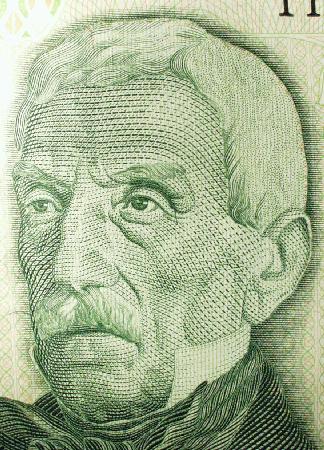
-
Young portrait on 100 peso note
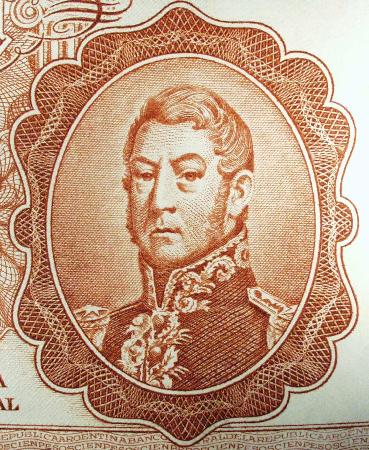
-
Old portrait on a commemorative stamp from 1850,
on cover to Pan American Union.
-
Inspired by the featured speaker's talk,
Reid Geissler
brought in many examples of mint errors.
-
The usual clipped planchets of various denominations were there,
as were some off-center strikes.
-
There was a South Carolina clad quarter missing its outer layer,
and some double struck coins: Lincoln cent, New Hampshire quarter, and 2000-D Sacagawea dollar.
There even was a broadstruck Sacagawea dollar.
-
There were some wrong planchet errors,
including 2000-D cent on a dime planchet,
Jefferson nickel on a dime planchet,
Delaware quarter on a nickel planchet,
and a 2000-D Sacagawea dollar on a quarter planchet.
-
Examples of overstruck on other denomination included:
Jefferson nickel struck over 2000 cent,
and a Jefferson nickel struck off-center over a 2000-D cent.
-
Mark Wieclaw
showed that he
has too many numismatic interests to be limited to a single theme.
-
Official elongated Australian pennies and half-pennies
for the Autralian Olympics.
-
Silver argentus brockage of Maximianus,
who is notable for having three reigns of
286-305, 306-308, and during 310.
-
Silver quinarius brockage of Marc Antony.
These last two coins were acquired from a recent
auction which included a collection of ancient brockages.
-
Dies for coins from the Philipines:
the 10 centavo obverse (of the style used from 1907-1945)
and a 1 centavo reverse of 1937.
Mention was made that many dies from that era
were brought back to the US by soldiers
after WW II, as souvenirs.
-
Concluding the program was
Bob Feiler
with a Spanish theme.
-
Large 3½" ultra high relief modern bronze medal from Madrid, Spain.
-
1542-55 One Reale from Mexico. Juana & Carlos
-
1734 Guatemala Four Reale
-
Spain One Reale late 1400s early 1500s Ferdinand & Isabella
-
1731 Mexico Eight Reale
-
Eight Reales from the Galleon San Jose sunk in 1733.
Our 982nd Meeting
| Date: | November 8, 2000 |
| Time: | 7:00 PM |
| Location: | Bank One Plaza Building
(formerly the First National Bank Building)
18th Floor, on Dearborn between Madison and Monroe.
Enter the building at the South entrance of the Dearborn side,
sign in at the security desk and take the elevator to the 18th floor. |
| Member Auction: |
Although the deadline for listing lots in the Chatter is past,
you can still bring your lots with you to the November meeting.
In the past few years, club
related material (and Chicago area numismatic items) have
realized the best results. Please consider using the club auction
to dispose of the numismatic items you no longer need.
You can place a reserve on each lot, and there is no commission
charged to either the buyer or seller. Auction lot viewing will
be held before the meeting starts, and again briefly before the
auction starts.
Please find elsewhere in this issue of the Chatter
a listing of all auction lots
that were known to us by Friday, October 20.
|
Important Dates
| Nov | 8 |
CCC Meeting - Club Auction - no featured speaker |
| |
| Dec | 13 |
CCC Meeting - Annual Banquet Meeting - Featured Speaker and other details to be announced. |
| |
| Jan | 10 |
CCC Meeting - who will be our first Featured Speaker of the 21st Century? |
Birthday and Year Joined
| December |
6 |
Albert F. Ivan |
1999 |
| December |
6 |
Allen H. Meyer |
1990 |
| December |
6 |
M. Michael Williams |
2000 |
| December |
7 |
Brian C. Stubbs |
1980 |
| December |
9 |
Howard Eisenberg |
1963 |
| December |
10 |
Mike Gasvoda |
1995 |
| December |
16 |
Michael Schmidt |
2000 |
| December |
19 |
Bill Grundy |
1980 |
| December |
26 |
Kevin J. Blocker |
2000 |
| December |
29 |
Nick Weiss |
1996 |
| December |
31 |
Philip J. Carrigan |
1989 |
Member Auction
-
1978 British Proof Set consisting of 6 regular circulating coins from ½ p
to 50p.
-
State of Illinois 1 ½ Mills Sales Tax Token issued in 1935 - first year
of issue. 15 pieces all in brilliant uncirculated condition.
-
Metal plate used to emboss "1873-1873" on the book 1873-1873 by Harry X
Boosel. Included is a copy of the book which is autographed by the author
and is hardbound with author's name embossed in gold. Apparently the author's
personal copy.
-
Six different bronze medals from the World War II Medal Series by
Presidential Art Medals, Inc. Each medal was designed and engraved by
Edward R. Grove a former US Mint employee. Each medal is housed in a hard
plastic holder placed in a box with a pamphlet describing the event and
person being commemorated.
-
American Numismatic Association Convention memrobilia: ANA 1929
Convention (held in Chicago) envelope (soiled and torn) containing the
Official Program (Very good condition). The envelope is numbered No. 2.
Also a ribbon stating "Chicago Coin Club - Reception Committee 1920", and a
ribbon that has faded but appears to say "Committee". Also a second
Official Program of 1929 soiled and torn and a form letter from CCC to ANA
members inviting them to the ANA Convention of 1933 and a blank page with
the same letterhead. 7 items total.
-
Silver medal commemorating the Chicago Fire. The obverse depicts Chicago
in flames. Engraved by W. Barber. The reverse states around the outer edge
"second anniversary memorial - In commemoration of the great Chicago fire
Oct. 8-9, 1871" and in the center "Made at the interstate industrial
Exposition of Chicago Oct. 1873, Chicago rebuilt pop. 400,000. In 1823 pop.
50. Dedicated in gratitude to the World". Weighs 29.2 dwt. In excellent
condition.
-
same as above except added metal at top and holed to wear as jewelry.
U.S. error coins and other items:
-
"Sac" Blank Planchet. MB: $50
-
Off-Center New Hampshire State Quarter. MB: $100
-
100 Different Elongated Cents. MB: $10
-
Set of 7 Type I and Type II Blank
Planchets - Cent thru Quarter. MB: $20
-
Two Sets of Off Center Errors-Cent thru Quarter. MB: $20 each set
-
Two Sets of Broadstrike Errors Cent, Nickel, Dime. MB: $30 each set
-
Broadstrike 1999-P SBA $1. MB: $50
-
Set of Transportation Tokens. MB: $10
Chicago Coin Club
-
Set of 80th Anniversary plaquettes in bronze, silver, and gold.
Group of ANA Convention auction catalogs
-
1961, Atlanta, World Numismatiques Inc.
-
1966, Chicago, A. Kosoff and Numismatic Enterprises
-
1969, Philadelphia, Paramount
-
1973, Boston, Jess Peters
-
1983, San Diego, Kagin's (with prices realized)
-
1984, Detroit, Kurt R. Krueger
-
1989, Pittsburgh, Bowers & Merena (with prices realized)
-
1994, Detroit, Heritage Numismatic Auctions
-
1996, Denver, Heritage Numismatic Auctions
Other numismatic material
-
Chicago Coin Club Bulletin, Annual Number 1952 (includes membership
directory)
-
Chicago Coin Club Bulletin 1969, Xerox copy with rubber stamp (in Xerox)
of Trygve A. Rovelstad, Sculptor (history of club medals, etc.)
-
Chicago Coin Club Bulletin, Bicentennal Issue 1976 (list of members,
awards, medals, etc.)
-
Check for $42.72 signed by Harry F. Flower as treasurer of Men's Club of
West Suburban Temple Har Zion, 3-31-1971, drawn on Oak Park National Bank
-
Booklet (40 p.), Reading Medieval European Coins by Ralph S. Walker, 1979
(1st ed.)
-
Bond coupon of The Plymouth, Kankakee and Pacific Railroad Company, $35
in Gold, paid Jany. first, 1901 (cancelled)
-
Medinah Temple, Chicago Shrine medal, Frank C. Roundy, Imperial Potentate
A.A.O.N.M.S., Sept. 27, 1907, brass
-
Palestine 1 mil coin 1927 EF, KM 1, inscriptions in English, Arabic and
Hebrew
CHICAGO NUMISMATIC SOCIETY:
-
1909 U.S.S. Nashville Medal - Bronze in green velvet lined case
-
1909 U.S.S. Nashville Medal - Sterling Silver in purple velvet lined case with card no. 1161
from Bower and Merena auction (June 1984) of Virgil Brand Collection
-
As no. 2, but card no. 1162
-
1910 Progress in Aviation Medal - Bronze
-
1910 Progress in Aviation Medal - Sterling Silver
CHICAGO COIN CLUB:
-
1927 100 Meeting Medal, bronze
-
As above
-
1944 25th Anniversary Medal, Sterling Silver w/portrait of Lincoln
-
As above
-
1952 400th Meeting counterstamped 1944 Mexican peso
-
As above
-
1952 CCC initials (from above medal) counterstruck bronze Central Illinois Numismatic Society
medal honoring the Club's first place award for their National Coin Week efforts
-
As above
-
1959 Fall Festival - brass
-
As above
-
1960 500th meeting barrel-shaped medal - bronze
-
1960 500th meeting barrel-shaped medal - Sterling silver
-
1961 Fall Festival - brass
-
As above
-
1961 - 4 different elongated Lincoln cents rolled by Leonard Stark at 1961 CCC Fall Festival
-
1962 Fall Festival - brass
-
As above
-
1969 50th Anniversary Medal - bronze
-
As above
-
1969 50th Anniversary Medal in red Capitol Plastics holder - Sterling silver
-
As above, but in black Capitol Plastics holder
-
1969 uniface reverse of 50th Anniversary Medal struck for award purposes - nickel
-
1969 Six Hundredth Meeting, brass
-
As above
-
1981 750th Meeting counterstamped 1981 Kennedy half dollar
-
As above
-
1981 750th Meeting counterstamped 1919 Walking Liberty half dollar
-
As above
-
1987 CICF elongated 1919 Lincoln cent (819th meeting)
-
As above, but 1919 Mercury dime
-
1988 CICF 5-piece set of elongated coins with story card
-
1989 CICF Leather Money token good for $2.00 with story card
-
1991 CICF Stone Money token good for $5.00 with story card
-
1995 CICF Chinese Knife Money (replica) token good for $5.00 with story card
-
No Date - CCC logo on two wooden nickels
-
1920 Chicago ANA Convention badge in Sterling silver and original box
-
1956 Chicago ANA Convention badge w/o ribbon - bronze
-
As above, but badge is enameled and purple ribbon attached
-
1956 CCC logo portion of above badge enameled and made into bolo tie clasp
-
No date - CCC logo acid etch, gold plated and jump ring added
-
1965 3-piece medal set for CCC hosted Central States Numismatic Society Convention,
all with Lincoln's portrait in copper, aluminum and Sterling silver, in original display box
Other Numismatic items:
-
1974 Illinois Numismatic Assn. one troy ounce, .999 fine silver
-
No Dates - 3 different 1 ¼" bronze medals with pin back ribbons attached
-
12 poker chips: one $500 chip for Las Vegas Thunderbird
and two have no value but are from the Back Stage Cocktail Lounge;
the remaining nine are generic. Two chips are made of a multicolored "10 ½ gram clay"
compound and the other ten are made of polystrene
-
13 auction catalogs from Numismatic Lanz, Munich, Germany featuring ancient coinage from 1983-1989
-
25 auction catalogs from Numismatic Lanz, Munich, Germany,
featuring ancient coinage with most having several pages of colored photographs, 1989-2000
-
18 auction catalogs from Bank Leu, Zurich, Switzerland, most featuring ancient coinage, 1981-94
-
18 auction catalogs from Schweizerische Kreditanstalt and Credit Suisse, Zurich, Switzerland, 1984-92
-
U.S. 2000 type set 24 kt. gold plated in specially made presentation box.
Quarter is the Massachusetts Commemorative; all struck at Philadelphia,
except nickel was struck in Denver.
Chatter Matter
All correspondence pertaining to Club matters
should be addressed to the Secretary and mailed to:
CHICAGO COIN CLUB
P.O. Box 2301
CHICAGO, IL 60690
Visit Our Web Site
http://www.ece.iit.edu/~prh/coins/ccc.html
Contacting Your Editor
Paul Hybert
ECE Dept, IIT
3301 S. Dearborn
Chicago, IL 60616 |
| prh@ece.iit.edu |
| 1-312-567-3976 |
Club Officers
| Carl Wolf | - President |
| Steven Zitowsky | - First Vice President |
| Robert Feiler | - Second Vice President |
| |
| Directors: | Paul Hybert
Mike Metras
Jeff Rosinia
Mark Wieclaw |
| |
| Other positions held are: |
| Richard Hamilton | - Secretary Treasurer |
| Paul Hybert | - Chatter Editor |
| Phil Carrigan | - Archivist |
